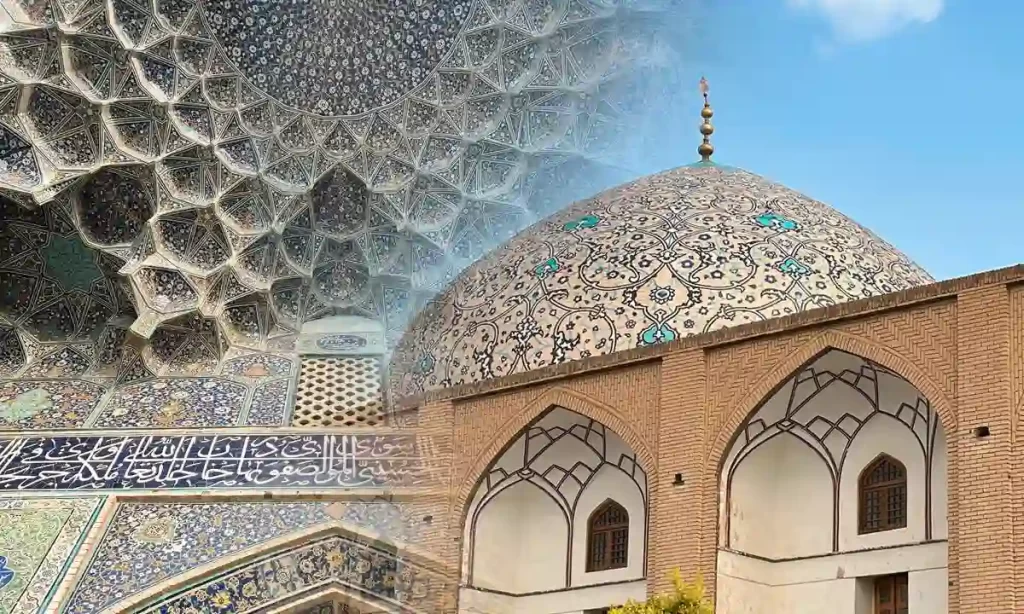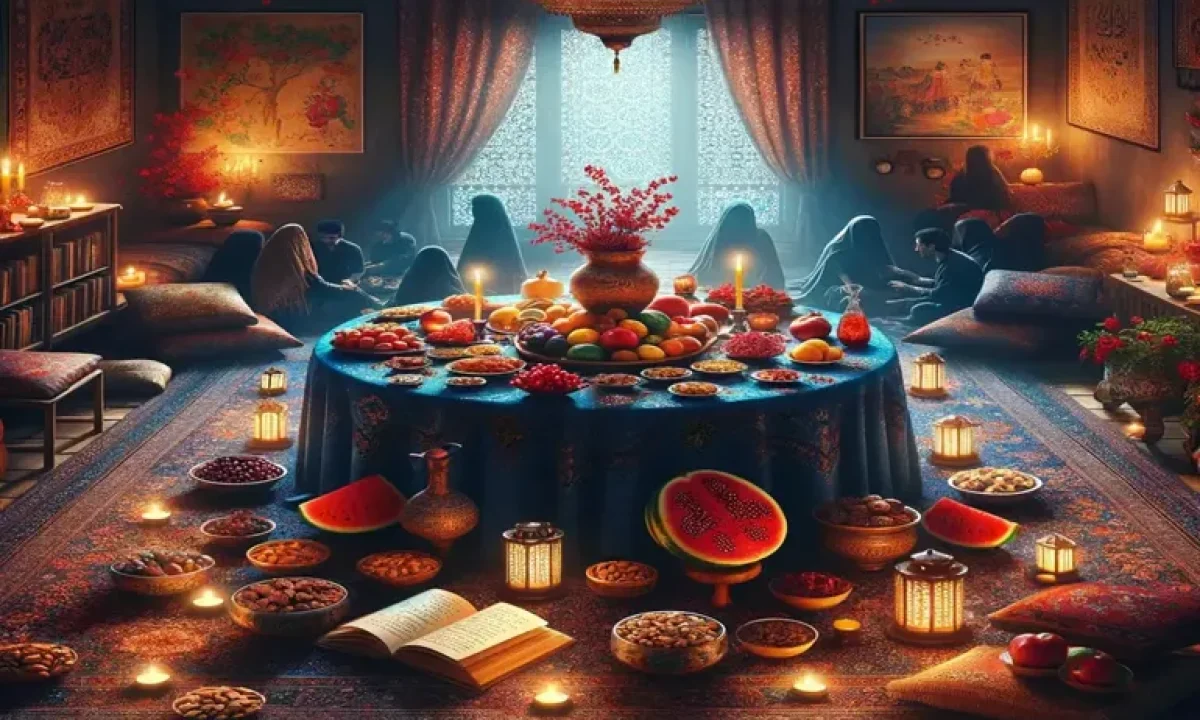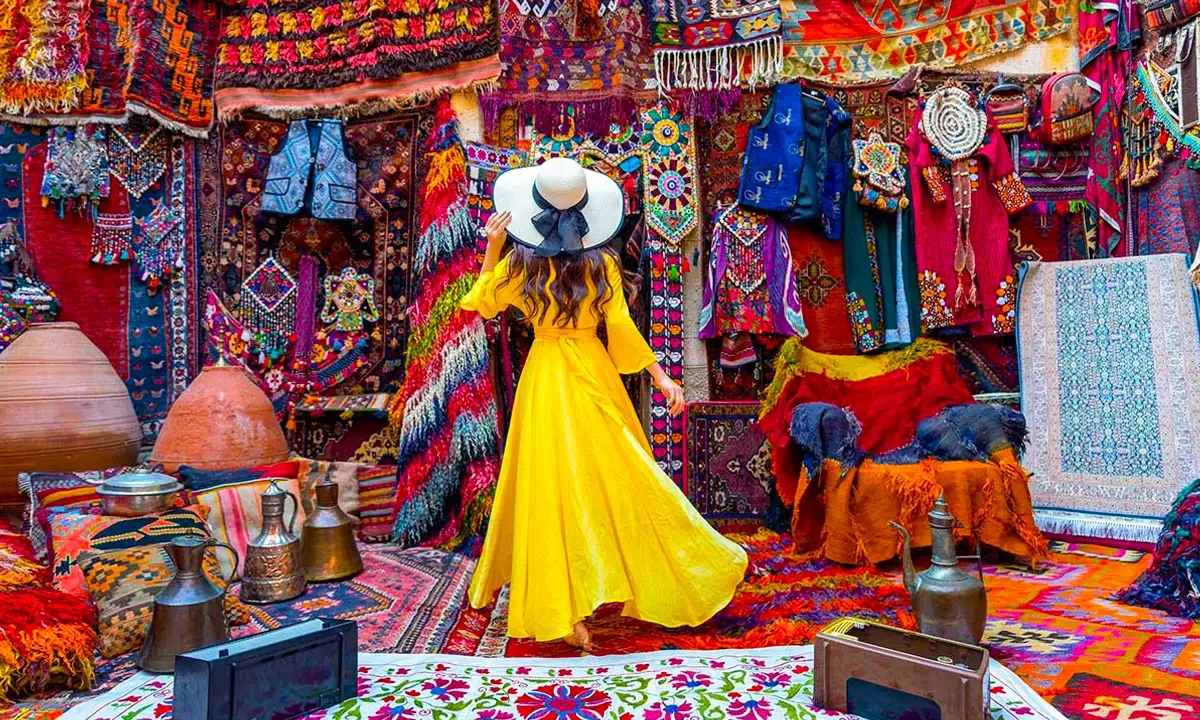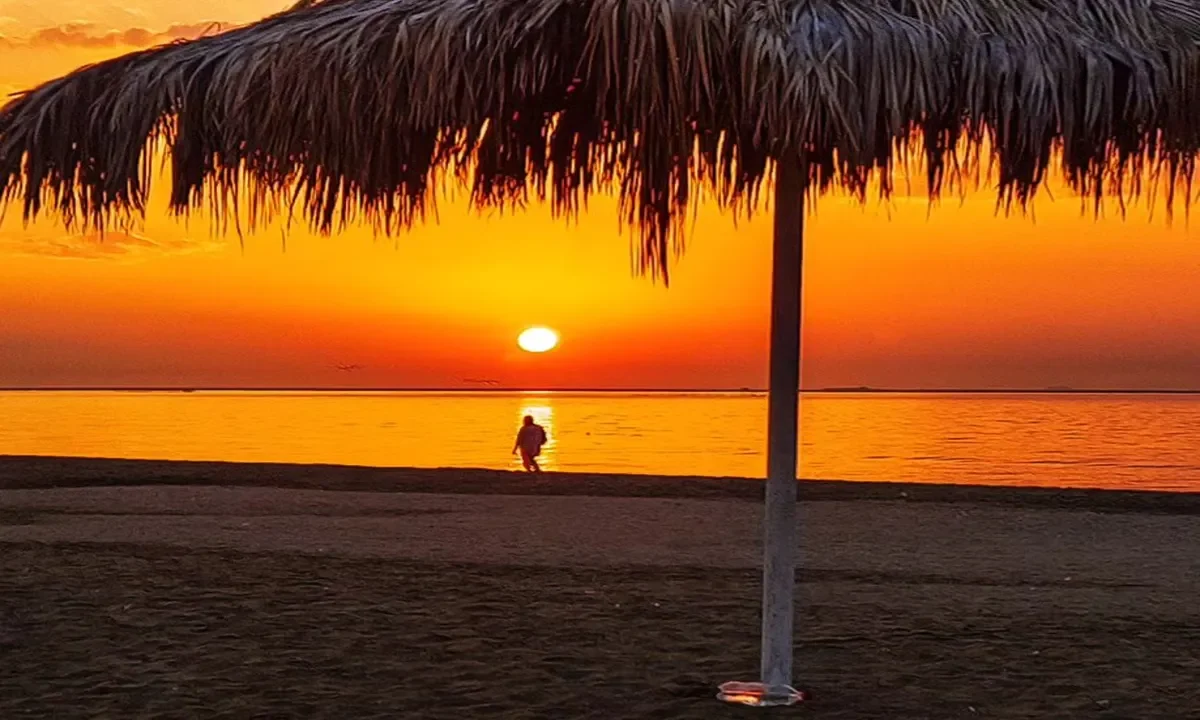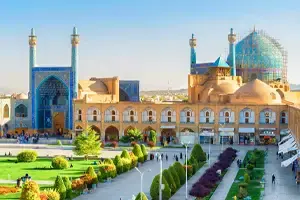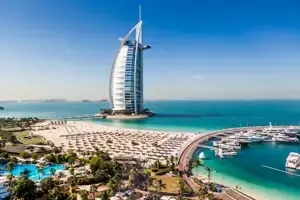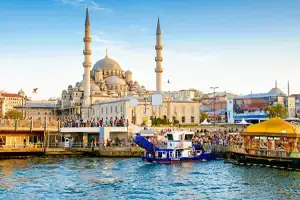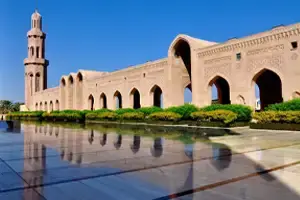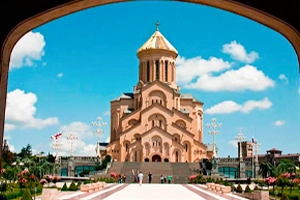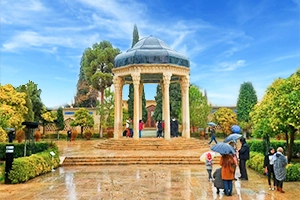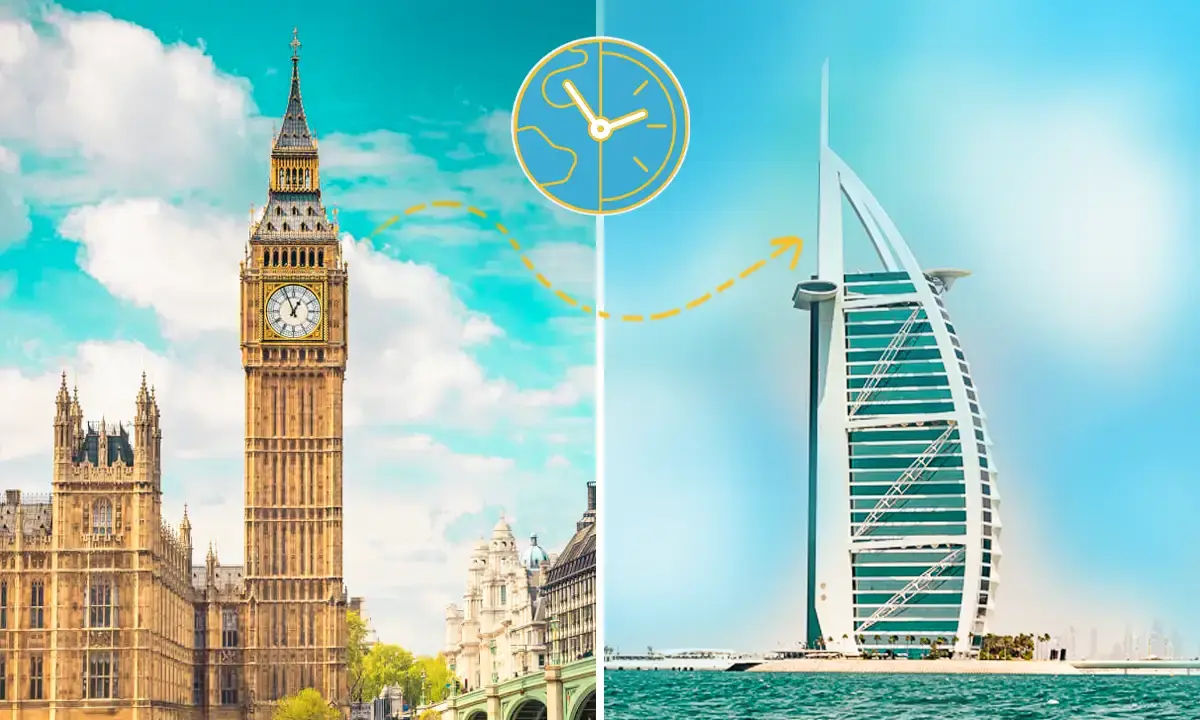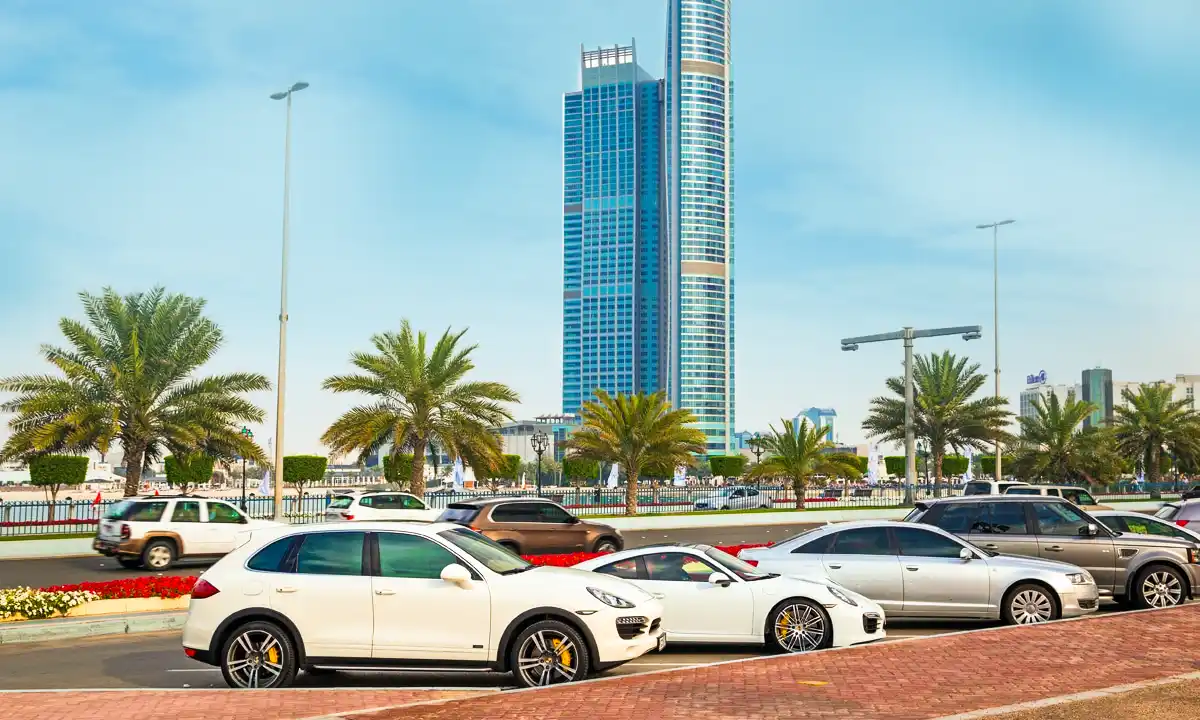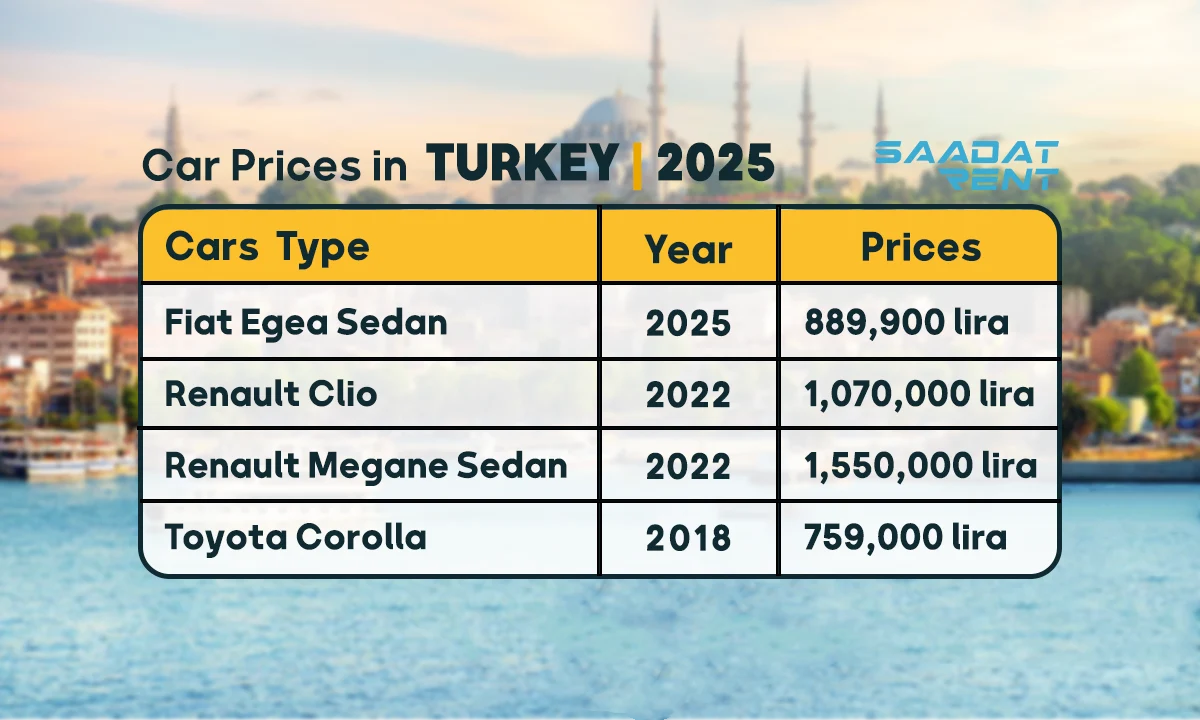In this guide, we’ll explore some of the top mosques in Iran, showcasing their architectural splendor and deep cultural significance. We aim to equip you with essential insights and practical tips, ensuring a respectful and enriching experience. From understanding the best times for visits to adhering to dress codes, this journey will unveil the beauty and history of these sacred spaces, offering a glimpse into Iran’s rich heritage.
Places like Nasir al-Mulk, Shah Mosques, Jameh Mosque of Yazd, and Sheikh Lotfollah are considered to be the top mosques in Iran. However, this country has many more captivating places to offer. So let’s dive into them.
Nasir al-Mulk Mosque
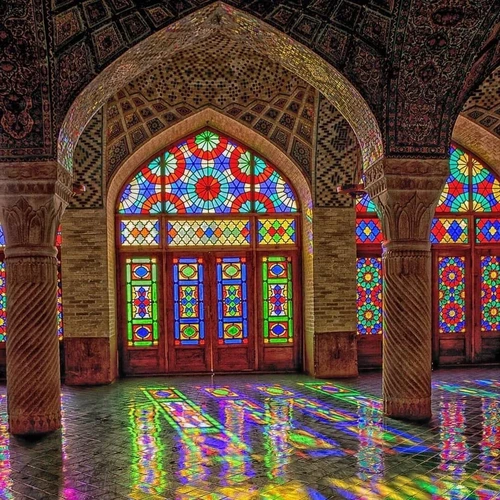
The Nasir al-Mulk Mosque, nestled in the vibrant city of Shiraz, is a marvel of Qajar-era architecture, renowned for its spectacular display of stained glass. Each morning, as the sun rises, its rays dance through the colorful windows, casting a breathtaking spectrum of light across the mosque’s intricately designed interior. This creates a mesmerizing effect, transforming the space into a canvas of light and color. The mosque’s beauty is further enhanced by detailed tile work and elegant arches, embodying the rich artistic heritage of Iran. This architectural gem offers a visually stunning experience, capturing the essence of Persian craftsmanship and spiritual elegance.
Jameh Mosque of Isfahan
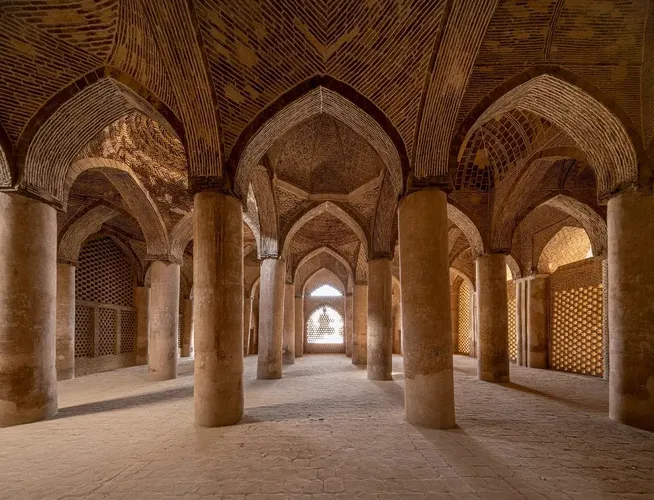
The Jameh Mosque of Isfahan, a UNESCO World Heritage site, stands as a testament to the evolution of mosque architecture over twelve centuries in Iran. This architectural marvel is one of the oldest mosques in the country, with foundations dating back to the Umayyad era, though it has undergone numerous renovations and expansions over the years. Its grand scale and complex design reflect a fusion of styles from different periods, showcasing Islamic architectural advancements through the ages.
Central to the mosque’s beauty are its stunning domes, adorned with intricate tile work in azure and turquoise, and its vast, imposing iwans (vaulted spaces) that lead into the central courtyard. The mosque’s layout is a sprawling network of prayer halls, courtyards, and domes, each telling a story of the era in which they were added.
Visitors to the Jameh Mosque of Isfahan are often struck by its serene atmosphere and the sheer scale of its construction. Walking through its arcades, one can admire the detailed stucco work, calligraphy, and mosaic tiles that decorate its walls and ceilings. The mosque not only serves as a place of worship but also as a cultural and historical repository, offering a deep dive into the architectural and spiritual heritage of Iran.
Shah Mosque
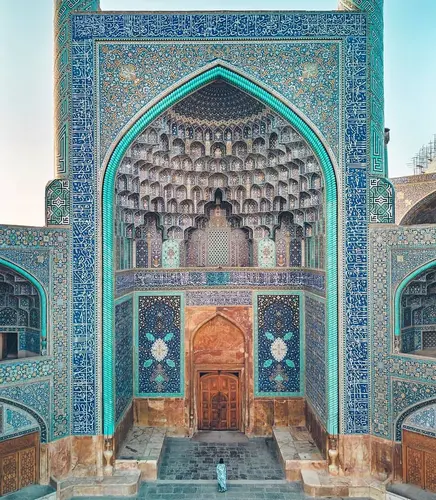
The Shah Mosque, nestled in Isfahan’s Naqsh-e Jahan Square, epitomizes the zenith of Islamic and Persian architecture. Built during the Safavid dynasty in the 17th century, its grandeur is immediately apparent from its towering entrance, leading to a vast courtyard surrounded by stunning iwans. The mosque’s dome, a masterpiece of design, is adorned with exquisite tilework in shades of blue and turquoise, mirroring the celestial vault. Inside, visitors are captivated by intricate mosaics, calligraphy, and an ingenious acoustic design that amplifies the spiritual resonance of the space. This architectural jewel not only serves as a place of worship but also as a testament to the rich cultural and artistic legacy of Iran, offering a mesmerizing experience of tranquility and beauty.
Sheikh Lotfollah Mosque
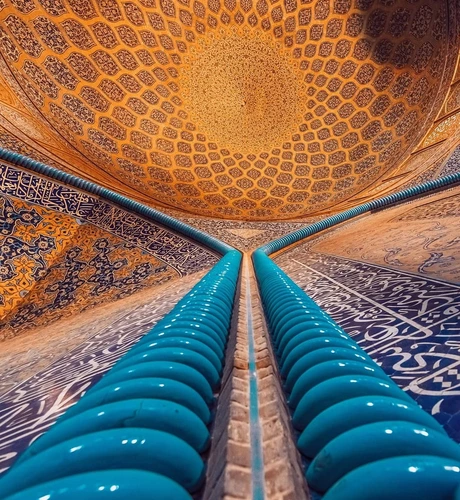
Sheikh Lotfollah Mosque, a masterpiece of Persian architecture, is located on the eastern side of Naqsh-e Jahan Square in Isfahan, Iran. Unlike many other mosques, it was not designed for public congregational prayers but rather for the private use of the royal court. Completed in 1619 during the reign of Shah Abbas I, this mosque is renowned for its exquisite dome, which features a complex design of peacock motifs at its pinnacle, visible when sunlight hits the center. The exterior tiles shift in color from dawn to dusk, moving from cream to pink hues, reflecting the changing light of the day.
The interior of Sheikh Lotfollah Mosque is equally stunning, with its intricate lattice windows, fine mosaic tiles, and detailed calligraphy, embodying the zenith of Safavid architectural and artistic expression. The central chamber, illuminated by natural light, houses an elegantly designed mihrab (prayer niche) that captivates visitors with its profound beauty and serenity. The mosque’s lack of minarets and a courtyard emphasizes its purpose as a space of intimate worship and reflection, making it a unique architectural gem in Iran’s rich cultural landscape.
Jameh Mosque of Yazd
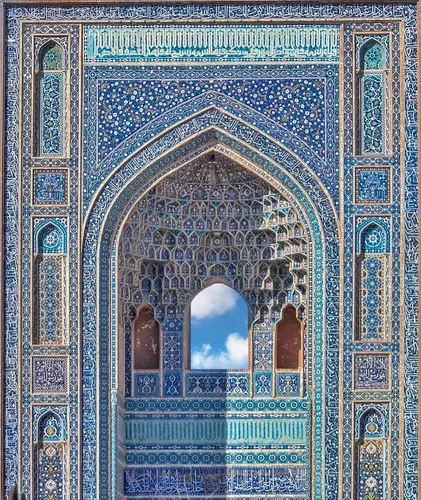
The Jameh Mosque of Yazd, standing tall with its striking minarets and splendid facade, is a significant landmark in the ancient city of Yazd, Iran. Renowned for its 12th-century origins and subsequent adaptations over centuries, this mosque is a showcase of Islamic and Persian architectural evolution. The mosque’s entrance is framed by a pair of towering minarets, the highest in Iran, leading to a majestic courtyard surrounded by intricate tile work in shades of blue and turquoise. Inside, the mosque features a vast array of decorative elements, from exquisite mosaics and detailed calligraphy to impressive domes that echo the spiritual chants within. The Jameh Mosque of Yazd not only serves as a center for worship but also as a testament to the enduring beauty and complexity of Persian Islamic architecture, inviting visitors to explore its historical depth and artistic splendor.
Blue Mosque
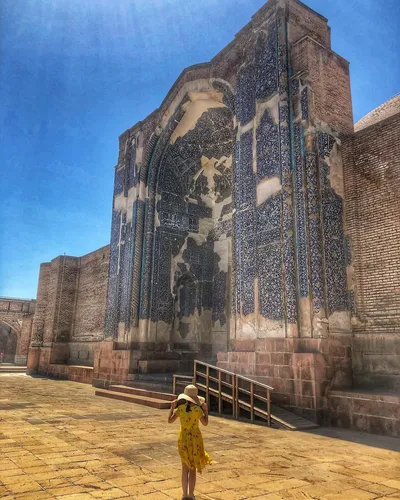
The Blue Mosque, also known as the Mosque of Kabud, graces the city of Tabriz, Iran, with its remarkable structure and historical significance. Constructed in the 15th century during the rule of the Qara Qoyunlu dynasty, this mosque is renowned for its extensive use of blue tiles, which have given it its name. The intricate designs and patterns that adorn its interior and exterior walls are masterpieces of Islamic art, showcasing an exquisite blend of calligraphy and geometric motifs. Although it was heavily damaged by an earthquake in the late 18th century, restoration efforts have preserved its beauty and majesty. The mosque’s surviving grand entrance iwan and prayer hall continue to mesmerize visitors with their stunning azure hues and artistic detail, making the Blue Mosque a poignant symbol of Iran’s rich cultural heritage and architectural prowess.
Agha Bozorg Mosque
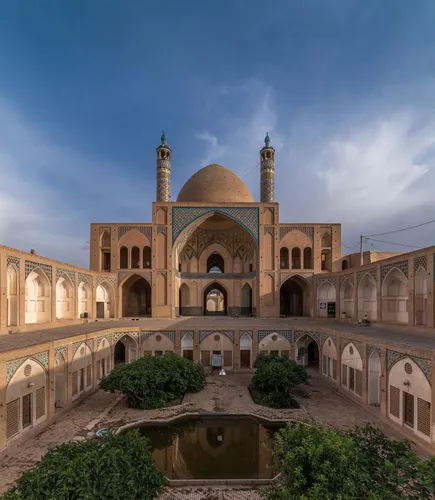
The Agha Bozorg Mosque is a distinguished example of 19th-century Persian architecture, located in the heart of Kashan, Iran. This mosque-school complex was designed as a theological school and is celebrated for its symmetrical design, showcasing the architectural ingenuity of the Qajar era. Agha Bozorg Mosque is particularly notable for its sunken courtyard, which allows for cooler temperatures and creates an impressive spatial effect, enhancing the mosque’s aesthetic and functional appeal. The central courtyard is flanked by two-story arcades, with the mosque’s prayer hall on one side, featuring a beautifully crafted dome that dominates the skyline. Intricate tilework, stucco decorations, and woodwork throughout the complex exemplify the high level of craftsmanship achieved during this period. Agha Bozorg Mosque serves not only as a place of worship but also as a community center, maintaining its role as a vibrant hub of religious and educational activity, making it a must-visit site for those interested in the rich tapestry of Iranian culture and Islamic architecture.
Vakil Mosque
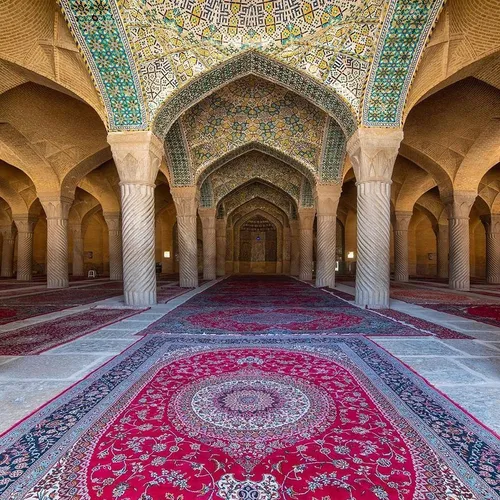
The Vakil Mosque, located in Shiraz, Iran, is a splendid example of 18th-century Persian architecture, built during the Zand dynasty. Renowned for its vast, columned prayer hall and intricate floral tilework, the mosque exemplifies the aesthetic elegance and architectural innovation of its time. The mosque’s most striking feature is its forest of 48 twisted columns, each carved from a single piece of stone, supporting the beautifully crafted ceiling. The extensive use of colorful tiles creates elaborate patterns and Quranic inscriptions on the walls and ceilings, offering a visual feast for visitors. The spacious courtyard, with its central pool and surrounding arcades, provides a tranquil space for reflection amidst the mosque’s grandeur. The Vakil Mosque’s blend of architectural beauty, historical significance, and serene atmosphere makes it a key attraction in Shiraz, reflecting the cultural richness and artistic achievements of the Zand period.
Ancient Jameh Mosque of Qazvin
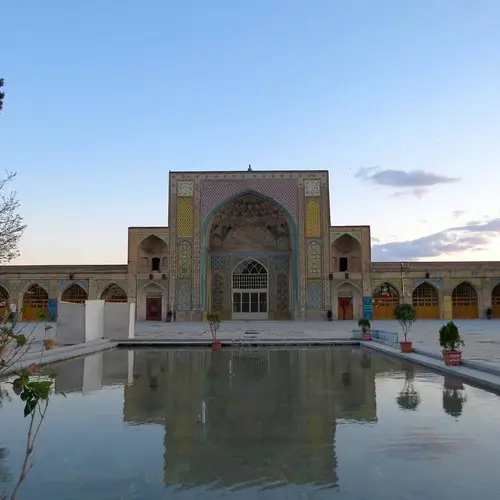
The Ancient Jameh Mosque of Qazvin, one of the oldest mosques in Iran, is a monumental structure that embodies the evolution of Islamic architecture over the centuries. Situated in Qazvin, this mosque has roots stretching back to the Sassanian era, with significant additions and renovations made during the Islamic period, particularly under the Seljuk, Safavid, and Qajar dynasties. Its architecture is a fascinating blend of styles, reflecting the mosque’s long history and the diverse cultural influences that have shaped it.
The mosque’s sprawling complex includes several domes, with the Shazdeh Hossein shrine being a notable feature, characterized by its exquisite tilework and intricate designs. The mosque also boasts impressive iwans (vaulted open rooms) and a vast courtyard that serves as a communal gathering space, enhancing its role as a center for worship and community life. The variety of decorative elements, from intricate stucco work to calligraphy and tilework, showcases the artistic mastery of different eras.
The Ancient Jameh Mosque of Qazvin is not just a place of worship; it’s a living museum that tells the story of Iran’s architectural and cultural evolution, making it a must-visit for those interested in the depth and diversity of Islamic art and architecture.
Borujerd Jame Mosque
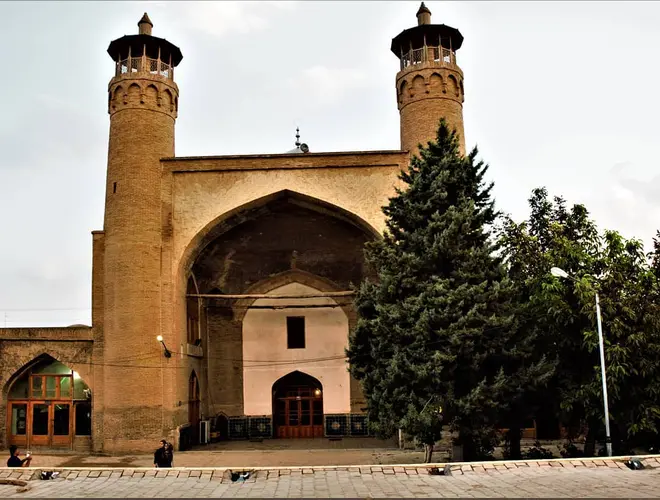
The Borujerd Jame Mosque, also known as the Grand Mosque of Borujerd, is an emblematic structure that stands as a testament to the rich historical and cultural tapestry of Borujerd, in the province of Lorestan, Iran. This mosque is distinguished by its long history, dating back to the Seljuk era, with renovations and additions made through subsequent periods, including the Safavid and Qajar dynasties, reflecting a blend of architectural styles and influences over the centuries.
Characterized by its stunning brickwork, the mosque features a spacious courtyard surrounded by arcades, a hallmark of traditional Islamic architecture. Its prayer hall is capped with a magnificent dome, intricately decorated with faience tilework showcasing exquisite Islamic motifs and calligraphy, illuminating the spiritual and artistic heritage of Iran.
One of the unique aspects of the Borujerd Jame Mosque is its adaptation to the local climate, incorporating elements such as large iwans and a deep central courtyard, which help moderate the temperature inside the mosque, making it a comfortable place for worshippers and visitors alike.
As a hub of religious, cultural, and social activity, the Borujerd Jame Mosque not only serves as a place of worship but also as a gathering space for the community, playing a vital role in the social fabric of Borujerd. Its historical significance, architectural beauty, and role in community life make it a noteworthy destination for those interested in exploring the depth of Iran’s Islamic traditions and architectural heritage.
Goharshad Mosque
Located in the heart of Mashhad, adjacent to the Imam Reza Shrine, Goharshad Mosque is one of the top mosques in Iran, admired for its breathtaking Persian-Islamic architecture and rich history. Built in 1418 AD during the Timurid dynasty, the mosque was commissioned by Goharshad Begum, the wife of Timurid ruler Shah Rukh, making it not only a religious landmark but also a tribute to the cultural and artistic achievements of the era.
The mosque features a stunning turquoise dome, towering minarets, and a spacious courtyard surrounded by elegantly designed iwans. One of the most striking aspects of Goharshad Mosque is its intricate tilework, which showcases mesmerizing floral and geometric patterns in shades of blue, white, and gold. The mosque’s muqarnas (stalactite-like decorations) and inscriptions in Thuluth calligraphy, written by the renowned Persian calligrapher Baysunghur Mirza, add to its artistic grandeur.
Over the centuries, the mosque has undergone several renovations due to damage from earthquakes and political unrest, yet it remains one of Iran’s most treasured architectural masterpieces. Today, it serves as an important religious site, attracting both pilgrims and visitors who come to admire its timeless beauty and spiritual atmosphere.
Jameh Mosque of Kerman
Situated in the historic city of Kerman, the Jameh Mosque of Kerman is one of the top mosques in Iran, known for its rich history, Islamic architectural elegance, and breathtaking entrance portal. This mosque was originally constructed during the 14th century under the rule of the Muzaffarid dynasty, but it has been influenced by later architectural styles, making it a fascinating blend of Ilkhanid, Safavid, and Qajar-era designs.
The most prominent feature of this mosque is its spectacular iwan (vaulted entrance), adorned with intricate blue tilework and inscriptions from the Quran. Unlike many mosques with multiple minarets, the Jameh Mosque of Kerman is unique for having a single towering minaret, which adds to its distinctive character. The interior of the mosque boasts a large central courtyard, surrounded by prayer halls with stunning brick and tile decorations. The mihrab (prayer niche), decorated with exquisite stucco carvings and calligraphy, is another highlight of this historic site.
Beyond its architectural beauty, this mosque has witnessed significant events in Iranian history. Despite enduring damage from wars and natural disasters, it has been carefully restored, preserving its status as an architectural jewel of Kerman. Visitors can explore the mosque and experience its peaceful atmosphere, while also discovering the surrounding Grand Bazaar of Kerman, which adds to the cultural charm of the area.
Sepahsalar Mosque
Among the top mosques in Iran, Sepahsalar Mosque in Tehran stands out as an architectural masterpiece from the Qajar period. Built in the 19th century under the patronage of Mirza Hossein Khan Sepahsalar, the then-Prime Minister of Naser al-Din Shah, this mosque is one of the most grandiose religious structures in Tehran, showcasing a harmonious blend of Persian and Ottoman architectural influences.
Located near Baharestan Square, this mosque features an enormous central dome, eight towering minarets, and an expansive courtyard that can accommodate thousands of worshippers. The Persian-style tilework on the façade is decorated with floral motifs and intricate calligraphy, while the mosque’s prayer halls and arched corridors exhibit elegant stucco decorations and wooden inlays. The mosque is also known for its impressive chandeliers and stained-glass windows, which add to the grandeur of its interior design.
One of the unique aspects of Sepahsalar Mosque is its connection to Sepahsalar School, one of the oldest and most prestigious Islamic seminaries in Tehran. Over the years, this mosque has played a significant role in Iran’s religious and political history, often serving as a gathering place for important public events.
Today, Sepahsalar Mosque remains a prominent religious and architectural landmark in Tehran, attracting both worshippers and visitors eager to explore one of Iran’s finest examples of Qajar-era mosque design. Its historical significance, combined with its stunning aesthetic, makes it a must-visit destination for anyone interested in Iran’s rich cultural and architectural heritage.
Last Word
Top mosques in Iran are a testimony to the rich and diverse Persian and Islamic history and culture. Iranians showcase their mastery of art and architecture at these holy sites. There are awe-inspiring churches and cathedrals in the Christian world, and there are Jameh and historical Iran’s mosques that capture the grandeur of the Islamic world.
We covered some of the top mosques in Iran that everyone should see. Save some time on your Iran trip to explore some of these engaging attractions. Also, make sure you follow the conventional guidelines to avoid any difficulties.
